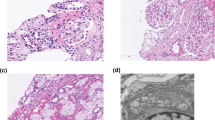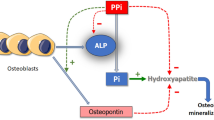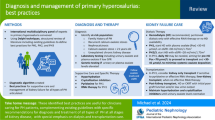Abstract
Hypoxanthine-guanine phosphoribosyltransferase (HPRT, EC 2.4.2.8) is a purine salvage enzyme that catalyses the conversion of hypoxanthine and guanine to their respective mononucleotides. Partial deficiency of this enzyme can result in the overproduction of uric acid leading to a severe form of gout, whilst a virtual absence of HPRT activity causes the Lesch-Nyhan syndrome which is characterised by hyperuricaemia, mental retardation, choreoathetosis and compulsive self-mutilation. The HPRT-encoding gene is located on the X chromosome in the region q26–q27 and consists of nine exons and eight introns totalling 57 kb. This gene is transcribed to produce an mRNA of 1.6 kb, which contains a protein encoding region of 654 nucleotides. With the advent of increasingly refined techniques of molecular biology, it has been possible to study the HPRT gene of individuals with a deficiency in HPRT activity to determine the genetic basis of the enzyme deficiency. Many different mutations throughout the coding region have been described, but in the absence of precise information on the three-dimensional structure of the HPRT protein, it remains difficult to determine any consistent correlation between the structure and function of the enzyme.
Similar content being viewed by others
References
Argos P, Hanei M, Wilson JM, Kelley WN (1983) A possible nucleotide-binding domain in the tertiary fold of phosphoribosyltransferases. J Biol Chem 258:6450–6457
Bakay B, Nissinen E, Sweetman L, Francke U, Nyhan WL (1979) Utilisation of purines by an HPRT variant in an intelligent, nonmutilative patient with features of the Lesch-Nyhan syndrome. Pediatr Res 13:1365–1370
Chamberlain JS, Gibbs RA, Nguyen PN, Caskey CT (1988) Deletion screening of the Duchenne muscular dystrophy locus via multiplex DNA amplification. Nucleic Acids Res 16:11141–11156
Craig SP, McKerrow JH, Newport GR, Wang CC (1988) Analysis of cDNA encoding the hypoxanthine-guanine phosphoribosyltransferase (HGPTase) of Schistosoma mansoni; a putative target for chemotherapy. Nucleic Acids Res 16:7087–7101
Davidson B, Palella T, Kelley W (1988a) Human hypoxanthine-guanine phosphoribosyltransferase: a single nucleotide substitution in cDNA clones isolated from a patient with Lesch-Nyhan syndrome (HPRTMidland). Gene 68:85–91
Davidson B, Pashmforoush M, Kelley W, Palella T (1988b) Genetic basis of hypoxanthine guanine phosphoribosyltransferase deficiency in patient with the Lesch-Nyhan syndrome (HPRTFlint) Gene 63:331–336
Davidson B, Chin SJ, Wilson J, Kelley W, Palella T (1988c) Hypoxanthine-guanine phosphoribosyltransferase — genetic evidence for identical mutations in two partially deficient subjects. J Clin Invest 82:2164–2167
Davidson BL, Tarle SA, Palella TD, Kelley WN (1989a) Molecular basis of hypoxanthine-guanine phosphoribosyltransferase deficiency in ten subjects determined by direct sequencing of amplified transcripts. J Clin Invest 84:342–346
Davidson B, Pashmforoush M, Kelley W, Palella T (1989b) Human hypoxanthine-guanine phosphoribosyltransferase deficiency — the molecular defect in a patient with gout (HPRTAshville) J Biol Chem 264:520–525
Davidson BL, Tarle S, Antwerp M van, Gibbs DA, Watts RWE, Kelley WN, Palella TD (1991) Identification of 17 independent mutations responsible for human hypoxanthine-guanine phosphoribosyltransferase (HPRT) deficiency. Am J Hum Genet 48:951–958
Edwards A, Voss H, Rice P, Civitello A, Stegemann J, Schwager C, Zimmermann J, Erfle H, Caskey CT, Ansorge W (1990) Automated DNA sequencing of the human HPRT locus. Genomics 6:593–608
Emmerson BT, Thompson L (1973) The spectrum of hypoxanthine guanine phosphoribosyltransferase deficiency. Q J Med 42:423–440
Emmerson BT, Gordon RB, Cross M, Thomson DB (1987) Plasma oxipurinol concentrations during allopurinal therapy. Br J Rheumatol 26:445–449
Finger S, Heavens RP, Sirinathsinghji DJ, Kuehn MR, Dunnett SB (1988) Behavioral and neurochemical evaluation of a transgenic mouse model of Lesch-Nyhan syndrome. J Neurol Sci 86:203–213
Free ML, Gordon RB, Keough DT, Beacham IR, Emmerson BT, DeJersey J (1990) Expression of active human hypoxanthineguanine phosphoribosyltransferase in Escherichia coli and characterisation of the recombinant enzyme. Biochim Biophys Acta 1087:205–211
Fujimori S, Hidaka Y, Davidson B, Palella TD, Kelley W (1988) Identification of a single nucleotide change in a mutant gene for hypoxanthine-guanine phosphoribosyltransferase (HPRT in Ann Arbor) Hum Genet 79:39–43
Fujimori S, Davidson B, Kelley W, Palella T (1989) Identification of a single nucleotide change in the hypoxanthine-guanine phosphoribosyltransferase gene (HPRTYale) responsible for Lesch-Nyhan syndrome. J Clin Invest 83:11–13
Fujimori S, Kamatani N, Nishida Y, Ogasawara N, Akaoka I (1990) Hypoxanthine-guanine phosphoribosyltransferase deficiency: nucleotide substitution causing Lesch-Nyhan syndrome identified for the first time among Japanese. Hum Genet 84:483–486
Gibbs DA, McFadyen IR, Crawford MD, DeMuinck MD, Head-house-Benson CM, Wilson TM, Farrant PH (1984) First-trimester diagnosis of Lesch-Nyhan syndrome. Lancet 24:1180–1183
Gibbs DA, Headhouse CM, Watts RE (1986) Family studies of the Lesch-Nyhan syndrome: the use of restriction fragment length polymorphism (RFLP) closely linked to the disease gene for carrier state and prenatal diagnosis. J Inher Metab Dis 9:45–58
Gibbs RA, Caskey CT (1987) Identification and localisation of mutations at the Lesch-Nyhan locus by ribonuclease A cleavage. Science 236:303–305
Gibbs RA, Nguyen PH, McBride LJ, Koepf SM, Caskey CT (1989) Identification of mutations leading to the Lesch-Nyhan syndrome by automated direct DNA sequencing of in vitro amplified cDNA. Proc Natl Acad Sci USA 86:1919–1923
Gibbs RA, Nguyen P-N, Edwards A, Civitello AB, Caskey CT (1990) Multiplex DNA deletion detection and exon sequencing of the hypoxanthine phosphoribosyltransferase gene in LeschNyhan families. Genomics 7:235–244
Goldstein M, Anderson LT, Reuben R, Dancis J (1985) Self-mutilation in Lesch-Nyhan disease is caused by dopaminergic denervation. Lancet 1:338–339
Gordon RB, Thompson L, Emmerson BT (1974) Erythrocyte phosphoribosylpyrophosphate concentrations in heterozygotes for hypoxanthine-guanine phosphoribosyltransferase deficiency. Metabolism 23:921–927
Gordon RB, Emmerson BT, Stout JT, Caskey CT (1987) Molecular studies of hypoxanthine-guanine phosphoribosyltransferase mutations in six Australian families. Aust N Z J Med 17:424–429
Gordon RB, Sculley DG, Dawson PA, Beacham IR, Emmerson BT (1990) Identification of a single nucleotide substitution in the coding sequence of in vitro amplified cDN A from a patient with partial HPRT-deficiency (HPRTBrisbane). J Inherited Metab Dis 13:692–700
Gordon RB, Dawson PA, Sculley DG, Emmerson BT, Caskey CT, Gibbs RA (1991) The molecular characterisation of HPRTChermside and HPRTCoorparoo — two Lesch-Nyhan patients with reduced amounts of mRNA. Gene 101:299–304
Greene ML (1972) Clinical features of patients with the “partial” deficiency of the X-linked uricaciduria enzyme. Arch Intern Med 130:193–198
Greene ML, Fujimoto WY, Seegmiller JE (1969) Urinary xanthine stones — a rare complication of allopurinol therapy. N Engl J Med 280:426–430
Green PM, Montandon AJ, Bentley DR, Ljung R, Nilsson IM, Gianelli F (1990) The incidence and distribution of CpG→TpG transitions in the coagulation factor IX gene. A fresh look at CpG mutational hotspots. Nucleic Acids Res 18/11:3227–3231
Gyllensten U, Erlich HA (1988) Generation of single-stranded DNA by the polymerase chain reaction and its application to direct sequencing of the HLA-DQA locus. Proc Natl Acad Sci USA 85:7652–7656
Hershey HV, Taylor MW (1986) Nucleotide sequence and deduced amino acid sequence of Escherichia coli adenine phosphoribosyltransferase and comparison with other analogous enzymes. Gene 43:287–293
Holden JA, Kelley WN (1978) Human hypoxanthine guanine phosphoribosyltransferase: evidence for tetrameric structure. J Biol Chem 253:4459–4463
Igarashi T, Minami M, Nishida Y (1989) Molecular analysis of hypoxanthine-guanine phosphoribosyltransferase mutations in five unrelated Japanese patients. Acta Paediatr Jpn (Overseas edn) 31:303–313
Johnson LA, Gordon RB, Emmerson BT (1976) Two populations of heterozygote erythrocytes in moderate hypoxanthine guanine phosphoribosyltransferase deficiency. Nature 264:172–174
Johnson GG, Kronert WA, Bernstein SI, Chapman VM, Smith KD (1988) Altered turnover of allelic variants of hypoxanthine phosphoribosyltransferase is associated with N-terminal amino acid sequence variation. J Biol Chem 263:9079–9082
Jolly DJ, Okayama H, Berg P, Esty AC, Filpula D, Bohlen P, Johnson GG, Shively JE, Hunkapillar R, Friedmann T (1983) Isolation and characterisation of a full-length expressible cDNA for human hypoxanthine phosphoribosyltransferase. Proc Natl Acad Sci USA 80:477–481
Kelley W, Wilson J (1982) Human hypoxanthine-guanine phosphoribosyltransferase: studies of the normal and five mutant forms of the enzyme. Am Clin Assoc 94:91–99
Kelley WN, Greene ML, Rosenbloom FM, et al (1969) Hypoxanthine-guanine phosphoribosyltransferase in gout. Ann Intern Med 70:155–160
Keough DT, Gordon RB, DeJersey J, Emmerson BT (1988) Biochemical basis of hypoxanthine phosphoribosyltransferase deficiency in nine families. J Inherited Metab Dis 11:229–238
Kozak M (1986) Selection of translational start sites in eukaryotic mRNAs. In: Matthews MB (ed) Translational control. Cold Spring Harbor Laboratory Press, Cold Spring Harbor, NY, pp 35–41
Kozak M (1987) At least six nucleotides preceding the AUG initiator codon enhance translation in mammalian cells. J Mol Biol 196:947–950
Lesch M, Nyhan WL (1964) A familial disorder of uric acid metabolism and central nervous system function. Am J Med 36:561–570
Lloyd KG, Hornykiewicz O, Davidson L, Shannak K, Parley I, Goldstein M, Shibuya M, Kelley WN, Fox IH (1981) Biochemical evidence of dysfunction of brain neurotransmitters in the Lesch-Nyhan syndrome. N Engl J Med 5:1106–1111
McKeran RO, Andrews TM, Howell A, Gibbs DA, Chinn S, Watts RWE (1975) The diagnosis of the carrier state for the Lesch-Nyhan syndrome. Q J Med 44:189–205
Migeon BR, Der Kaloustian VM, Nyhan WL, Young WJ, Childs B (1968) X-linked hypoxanthine-guanine phosphoribosyltransferase deficiency: heterozygote has two clonal populations. Science 160:425–430
Mihovilovic M, Lee J (1989) An efficient method for sequencing PCR amplified DNA. Biotechniques 7:14–16
Mizuno T, Yugari Y (1974) Self-mutilation in Lesch-Nyhan syndrome. Lancet 1:761
Mount SM (1982) A catalogue of splice junction sequences. Nucleic Acid Res 10:459–465
Musick WDL (1981) Structural features of the phosphoribosyltransferases and their relationship to the human deficiency disorders of purine and pyrimidine metabolism. CRC Crit Rev Biochem 11:1–34
Nyhan WL, Johnson HG, Kaufman IA, Jones KL (1980) Serotonergic approaches to the modification of behaviour in the Lesch-Nyhan syndrome. Appl Res Ment Retard 1:25–30
Ogasawara N, Stout JT, Goto H, Sonta SA, Matsumoto A, Caskey CT (1989) Molecular analysis of a female Lesch-Nyhan patient. J Clin Invest 84:1024–1027
Page T, Nyhan WL (1989) The spectrum of HPRT deficiency: an update. Adv Exp Med Biol 253A:129–134
Pai GS, Sprenkle JA, Do TT, Mareni CE, Migeon BK (1980) Localisation of loci for HPRT and glucose-6-phosphate dehydrogenase and biochemical evidence for non-random X-chromosome expression from studies of a human X-autosome translocation. Proc Natl Acad Sci USA 77:2810–2813
Patel PI, Nussbaum RL, Framson PE, Ledbetter DH, Caskey T, Chinault C (1984) Organisation of the HPRT gene and related sequences in the human genome. Somat Cell Mol Genet 10:483–493
Patel PI, Framson PE, Caskey CT, Chinault AC (1986) Fine structure of the human hypoxanthine phosphoribosyltransferase gene. Mol Cell Biol 6:393–403
Perutz MF (1990) Frequency of abnormal human haemoglobins caused by C→T transitions in CpG dinucleotides. J Mol Biol 213:203–206
Rockson S, Stone R, Van Der R, Kelley WN (1974) Lesch-Nyhan syndrome: evidence for abnormal adrenergic function. Science 186:934–935
Rosenbloom FM, Kelley WN, Miller J, Henderson JF, Seegmiller JE (1967) Inherited disorder of purine metabolism. J Am Med Assoc 202:175–177
Rosenbloom FM, Henderson JF, Caldwell IC, Kelley WN, Seegmiller JE (1968) Biochemical basis of accelerated purine synthesis de novo in human fibroblasts lacking hypoxanthine-guanine phosphoribosyltransferase. J Biol Chem 243:1166–1170
Saiki RK, Gelfand DH, Stoffel S, Scharf SJ, Higuchi R, Horn GT, Mullis CB, Erlich HA (1988) Primer-directed enzymatic amplification of DNA with a thermostable DNA polymerase. Science 239:487–491
Sanger F, Nicklen S, Coulson AR (1977) DNA sequencing with chain-terminating inhibitors. Proc Natl Acad Sci USA 74:5463–5467
Sculley DG, Dawson PA, Beacham IR, Emmerson BT, Gordon RB (1991) Hypoxanthine-guanine phosphoribosyltransferase deficiency: analysis of mutations by direct sequencing and allele-specific amplification. Hum Genet 87:688–692
Seegmiller JE, Rosenbloom FM, Kelley WN (1967) An enzyme defect associated with a sex-linked human neurological disorder and excessive purine synthesis. Science 155:1682–1684
Skopek TR, Recio L, Simpson D, Dallaire L, Melancon SB, Ogier H, O'Neill JP, Falta MT, Nicklas JA, Albertini RJ (1990) Molecular analyses of a Lesch-Nyhan syndrome mutation (HPRTMontreal) by use of T-lymphocyte cultures. Hum Genet 85:111–116
Stout JT, Caskey CT (1985) HPRT: gene structure, expression and mutation. Annu Rev Genet 19:127–148
Tarle SA, Davidson BL, Wu VC, Zidar FJ, Seegmiller JE, Kelley WN, Palella TD (1991) Determination of the mutations responsible for the Lesch-Nyhan syndrome in 17 subjects. Genomics 10:499–501
Urlaub G, Mitchell PJ, Ciudad CJ, Chasin LA (1989) Nonsense mutations in the dihydrofolate reductase gene affect RNA processing. Mol Cell Biol 9:2868–2880
Watts RWE, Spellacy E, Gibbs DA, Allsop J, McKeran RO, Slavin GE (1982) Clinical, post-mortem, biochemical and therapeutic observations on the Lesch-Nyhan syndrome with particular reference to the neurological manifestations. Q J Med 51/201:43–78
Wilson J, Kelley W (1984) Human hypoxanthine-guanine phosphoribosyltransferase — structural alteration in a dysfunctional enzyme variant (HPRTMunich) isolated from a patient with gout. J Biol Chem 259:27–30
Wilson JM, Tarr GE, Mahoney WC, Kelley WN (1982a) Human hypoxanthine-guanine phosphoribosyltransferase. Complete amino acid sequence of the erythrocyte enzyme. J Biol Chem 257:10978–10981
Wilson J, Baugher BW, Mattes PM, Daddona P, Kelley W (1982b) Human hypoxanthine-guanine phosphoribosyltransferase — demonstration of structural variants in lymphoblastoid cells derived from patients with a deficiency of the enzyme. J Clin Invest 69:706–715
Wilson J, Tarr G, Kelley W (1983a) Human hypoxanthine-guanine phosphoribosyltransferase: an amino acid substitution in a mutant form of the enzyme isolated from a patient with gout (HPRT in London) Proc Natl Acad Sci USA 80:870–873
Wilson J, Frossard P, Nussbaum R, Caskey T, Kelley W (1983b) Human hypoxanthine-guanine phosphoribosyltransferase detection of a mutant allele by restriction endonuclease analysis (HPRT in Toronto) J Clin Invest 72:767–772
Wilson J, Kobayashi R, Fox I, Kelley W (1983c) Human hypoxanthine-guanine phosphoribosyltransferase — molecular abnormality in a mutant form of the enzyme (HPRT in Toronto) J Biol Chem 258:6458–6460
Wilson JM, Stout JT, Palella TD, Davidson BL, Kelley WN, Caskey CT (1986) A molecular survey of hypoxanthine-guanine phosphoribosyltransferase deficiency in man. J Clin Invest 77:188–195
Wolf SE, Migeon BR (1985) Clusters of CpG dinucleotides implicated by nuclease hypersensitivity as control elements of house-keeping genes. Nature 314:467–469
Wyngaarden JB, Kelley WN (1983) Gout. In: Stanbury JB et al. (eds) The metabolic basis of inherited disease, 5th edn. McGraw-Hill, New York, pp 1043
Yang TP, Patel PI, Chinault AC, Stout JT, Jackson LG, Hildebrand BM, Caskey T (1984) Molecular evidence for new mutations at the HPRT locus in Lesch-Nyhan patients. Nature 310:412–414
Yang TP, Stout JT, Konecki DS, Patel PI, Alford RL, Caskey CT (1988) Spontaneous reversion of novel Lesch-Nyhan mutation by HPRT gene rearrangement. Somat Cell Mol Genet 14:293–303
Author information
Authors and Affiliations
Rights and permissions
About this article
Cite this article
Sculley, D.G., Dawson, P.A., Emmerson, B.T. et al. A review of the molecular basis of hypoxanthine-guanine phosphoribosyltransferase (HPRT) deficiency. Hum Genet 90, 195–207 (1992). https://doi.org/10.1007/BF00220062
Received:
Issue Date:
DOI: https://doi.org/10.1007/BF00220062




